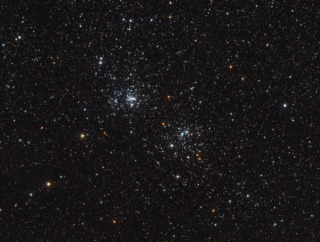
- Constellation: Perseus
- Right Ascension: 2h 20m
- Declination: 57° 08′
- Distance: 7,460 and 7,640 ly
The Double cluster in Perseus is a pair of open clusters (NGC 869 and NGC 884) located in the constellation of Perseus. Both are young clusters at an age of around 12.8 million year old, and contain many blue-white super giant stars. The clusters are located 7,500 light years distant and are separated from each other by several hundred light years. They are located in the Perseus arm of the Milky Way Galaxy, while we are located in the Orion arm.
- Details
- Category: Open Clusters
- Telescope: EDT 80mm Reftactor
- Camera: ZWO 1600 MM
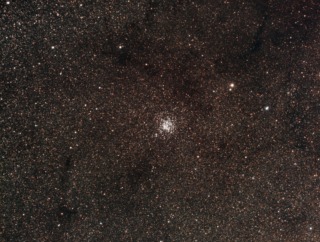
- Constellation: Scutum
- Right Ascension: 18h 51m 05.0s
- Declination: −06° 16′ 12″
- Distance: 6,120 ly
Messier 11 is an rich and compact open cluster located in the constellation of Scutum containing an estimated 2900 stars. It borders the northern end of the Scutum Cloud which is a dense section of the visible Milky Way. It's estimated age is between 220 and 250 million years. Like most open clusters, it's stars will eventually disperse through out the Milky Way. It was added to Charles Messier catalog in May, 1764.
Imaged wit
- Details
- Category: Open Clusters
- Telescope: EDT 80mm Reftactor
- Camera: ZWO 1600 MM
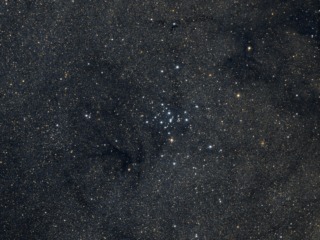
- Constellation: Scorpius
- Right Ascension: 17h 53m 51.2s
- Declination: −34° 47′ 34″
- Distance: 980 ly
An open cluster of stars in the constellation of Scorpio. The cluster consists of about 80 members, and lies at a distance of around 980 light years. Charles Messier cataloged the cluster in 1764. The cluster resides in front of the Milky Way backdrop showing a small sample of the estimated 100 billion stars that make up our Milky Way galaxy.
- Details
- Category: Open Clusters
- Telescope: EDT 80mm Reftactor
- Camera: ZWO 1600 MM
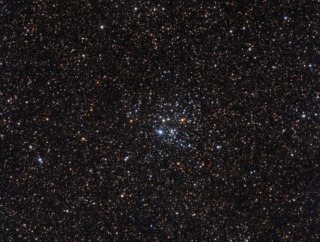
- Constellation: Scutum
- Right Ascension: 18h 45m 18.0s
- Declination: −09° 23′ 00″
- Distance: 5,160 ly
Messier 26 is an open cluster located in the constellation of Scutum. The cluster contains around 90 stars, with an estimated age of 89 million years. Distance to the cluster is 5,000 light years.
- Details
- Category: Open Clusters
- Telescope: GSO RC10
- Camera: ZWO 1600 MM
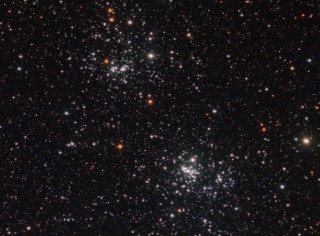
- Constellation: Perseus
- Right Ascension: 2h 20m
- Declination: 57° 08′
- Distance: 7,460 - 7,640 ly
NGC 869 and NGC 884 are commonly called the Double Cluster. Located in the constellation of Perseus, both are young clusters with an age of 12-13 million years old and are only separated by a few hundred light years. Estimated distance to the clusters is 7000 light years.
Oddly enough, Charles Messier didn't include them in his catalog, even though they were know from ancient times.
- Details
- Category: Open Clusters
- Telescope: EDT 80mm Reftactor
- Camera: Atik 314l+
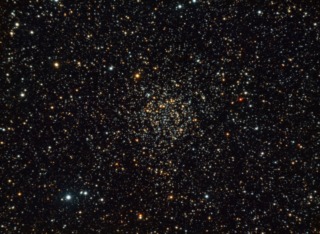
- Constellation: Cassiopeia
- Right Ascension: 23h 57m 24s
- Declination: +56° 42′ 30″
- Distance: 7,600 ly
NGC 7789 is an open cluster in Cassiopeia. Often called Caroline's Rose or The White Rose. It was discovered by Caroline Herschel in 1783. The cluster lies at a distance of 7600 light years away. I was curious about the particularly red bright star at the 2 o'clock position from the cluster. It is a red giant variable star of the Mira class, and its designation is WY Cas. In an approximately 476 day cycle, it varies from magnitude 16.9 up to a brightness of magnitude 10. It is near the peak in brightness in its cycle, but has no recent observations of its exact magnitude.
- Details
- Category: Open Clusters
- Telescope: EDT 80mm Reftactor
- Camera: Atik 314l+